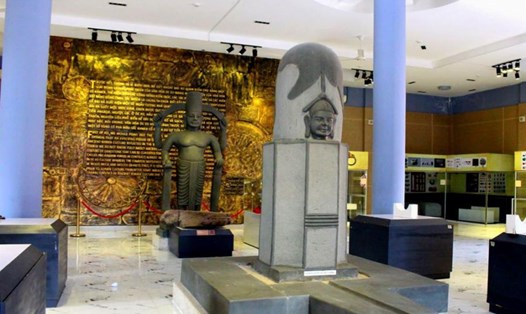Origin and characteristics of the famous Buddha Loi My
Oc Eo culture, developed from the 1st to the 7th centuries in the Southern Delta, is an outstanding ancient culture of Vietnam. Thanks to its favorable geographical location, Oc Eo residents have had the opportunity to interact with major cultures such as India, West Asia and Southeast Asia. This cultural continuation not only leaves an impression in the fields of trade and religion but also in sculpture, especially Buddhist works.
In the Southern region, Buddhism has soon settled down and become an important part of the spiritual life of the people of Oc Eo. This is proven through a series of ancient artifacts such as Buddha statues, pottery, jewelry and architectural relics. Among them, the statue of Buddha Lo My is a unique work of art, expressing the harmonious combination of importune influences and local features, while also showing the central role of Buddhism in the cultural life of Oc Eo.
The statue of Buddha Loi My was discovered in 1937 in Loi My hamlet, Phong My village, old Sa Dec (now in Dong Thap province). With a height of 200cm, a width of 50cm and a pedestal diameter of 41cm, the statue is carved entirely from a single-piece male wooden body, weighing about 100kg. This is a complete work, with special artistic and historical value, highly appreciated by experts from the ancient Golden Temple from the time of discovery.
The statue depicts the Buddha standing upright on a two-story lotus pedestal. The upper floor of the lotus platform is delicately carved with layers of round lotus leaves, sharp, interspersed with them, creating balance and softness. The lower floor is a layer of a steep lotus stand, supported by a sturdy round pillar. The front of the statue wears a round raincoat with a pointed hook, called Usnisa - a symbol of intelligence and enlightenment.
The face of the Buddha Loi My statue has unique characteristics: slightly broken face, gentle smiling lips, square chin and long ears almost touching the shoulders. The body is slender, the shoulders are slender, the two hands are bent at the corners to reach the chest level, creating a gentle but solemn feeling. The statue covers both shoulders, covering the legs long, creating graceful lines, exuding a graceful and sacred look.
symbolic meaning, "uniqueness endless"
The Loi My Buddha statue is said to be a copy of the Thich Ca Mau Ni Buddha, but there are many differences compared to the original Buddha statue at the Bo De Dao Trang Sanctuary (India). This reflects the adaptation and harmony of Buddhist art with local culture. According to Sammon Hue Thien, when Buddha declared and educated them in each land, he will transform into a suitable person for the people there. Therefore, the face and shape of Buddha statues in Asian countries often have their own characteristics, not completely similar to the original image of Indian Buddhism.
Another unique feature of the Buddha study statue is the eyes, with one closed eye and one wide-open eye. According to Buddhist classicology, this represents a state of deep and inner meditation, expressing peace of mind and the ability to refer to one's inner self. This is a delicate detail, showing the creativity and intelligence of Oc Eo artisans in conveying religious meaning through sculpture.
The image's cap position is also an important research topic. The right hand of the statue with the index finger and thumb touching each other, the remaining three fingers are placed straight, believed to be a manifestation of the Drmachakramudra - symbolizing the move of the wheel of the bust, or the Vitarkamudra - giving a gift of fearlessness. These details not only reflect the sophistication of art but also express the profound philosophical ideology of Buddhism.
The statue of Buddha Lo My is not only a work of art but also an important cultural and religious symbol, representing the brilliant development of Buddhism in Vietnam since the early AD. The statue has been selected by many international organizations and researchers as a research and exhibition object, contributing to promoting Oc Eo culture to the world. In 2008, the statue of Buddha Loy My was one of 18 Vietnamese Buddha statues at the Ho Chi Minh City Museum of History sponsored by the Cultural Conservation Ambassador Fund of the US State Department, included in the gold-plated lacquer recovery project with a total cost of 27,495 USD. This is a testament to the international community's interest and appreciation for the cultural and artistic values of the Buddha Loi My statue.
The statue of Buddha Lo My is one of the most valuable treasures of the Oc Eo culture and Southeast Asian Buddhist art. With ancient history, the statue not only reflects the technical and ideological level of the people of Oc Eo but also demonstrates the cultural and religious intersection in Vietnamese history. Quick information about the statue of Buddha Loi My: - Name: statue of Buddha Loi My. - Age: 4th - 6th century (Oc Eo culture). - Materials: Whole wood. - Dimensions: 200cm high, 50cm wide, 41cm platform diameter, 100kg weight. - Pose: Stand straight on a two-story lotus pedestal with your hands bent at the angle to reach your chest. - Features: Head wearing a round raincoat with a pointed hook (Usnisa), face slightly broken, one eye closed wide, body closed with both shoulders long down the legs. - Origin: Loi My Hamlet, Phong My Village, old Sa Dec (now in Dong Thap Province). - Current status: guarded at the Ho Chi Minh City Museum of History. - National Treasure: Recognized in 2012.











